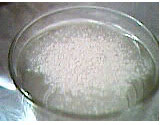


|
Powder in the surface
Science at Home |
||
|
Materials
|
Compounds
|
Videos:
download2.avi (244 KB) deterge. Pictures: 

|
|
Procedure
1. Fill two glasses of water. 2. Put talc powder in the surface of the two glasses. (put only a small amount of talc powder. Only the enough to cover the surface) 3. Wet a toothpick tip in shampoo. 4. Touch the center of the talc powder surface with the wet tip. 5. What do you observe? 6. Wet the second toothpick tip in detergent. (you can use a vulgar detergent) 7. Touch the center of the second powder surface. 8. What do you observe? |
||
|
Why?
The molecules in the water surface suffer strong attractions to the liquid bulk, not suffering opposite attractions. This fact implicates that in the water surface the forces aren't compensated and, as a result, there it will exist a phenomenon called superficial tension. When we add talc powder to the water surface, it will settle there because it will be establish an equilibrium between the water and powder molecules. More precisely, the talc powder particles will stay in the surface because the water will not be able to cover them due to the superficial tension. With the addition of shampoo or detergent to the center of the surface, the superficial tension influence will decrease in that point (Stubborn papers). The movement of the water to the glass borders drags the talc powder, breaking its surface. However, there exists a difference between the detergent and the shampoo, relatively to its capacity to decrease the water superficial tension. The detergent is a strong tense active agent, while the shampoo is moderate. The breaks in the powder surface observed for the detergent are bigger than the ones observed for the shampoo. It is also verified that the detergent makes that the powder particles become covered by the water, submerging them. Did you know that the lemon is also a tense active agent?
|
||
No part of this website can be reproduced without previous authorization. Please inform me if there is any problem with the website. |